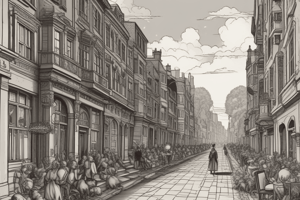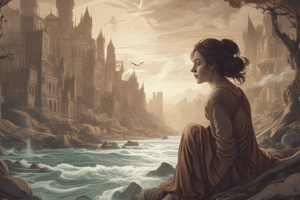Podcast
Questions and Answers
What is the main function of characterization in literature?
What is the main function of characterization in literature?
- To create physical descriptions of characters
- To reveal a character's personality (correct)
- To determine the plot structure
- To establish the setting of the story
What distinguishes a soliloquy from a monologue in drama?
What distinguishes a soliloquy from a monologue in drama?
- A monologue is shorter than a soliloquy
- A soliloquy is performed alone on stage (correct)
- A soliloquy is meant for audience ears only
- A monologue involves multiple characters
Which of the following statements best describes irony?
Which of the following statements best describes irony?
- It expresses a meaning different from the literal one (correct)
- It exclusively deals with positive outcomes
- It involves a character's direct statement
- It indicates a straightforward narrative
Which technique provides a warning or indication of future events in a narrative?
Which technique provides a warning or indication of future events in a narrative?
What is the purpose of a thesis statement in an essay?
What is the purpose of a thesis statement in an essay?
What does the term 'satire' refer to in literature?
What does the term 'satire' refer to in literature?
In literary terms, what does 'mood' refer to?
In literary terms, what does 'mood' refer to?
What defines a frame story?
What defines a frame story?
Which characteristic does a kenning possess?
Which characteristic does a kenning possess?
What does dramatic irony rely on?
What does dramatic irony rely on?
Flashcards
Allusion
Allusion
An indirect or passing reference to something.
Archetype
Archetype
A character type that repeats across different cultures and time periods.
Characterization
Characterization
The way an author reveals a character's personality.
Conflict
Conflict
Signup and view all the flashcards
Flashback
Flashback
Signup and view all the flashcards
Foreshadowing
Foreshadowing
Signup and view all the flashcards
Symbolism
Symbolism
Signup and view all the flashcards
Thesis
Thesis
Signup and view all the flashcards
Annotated Bibliography
Annotated Bibliography
Signup and view all the flashcards
Parody
Parody
Signup and view all the flashcards
Study Notes
Literary Devices & Techniques
- Allusion: Indirect reference to something else (e.g., historical event, famous work).
- Archetype: Recurring character type across cultures and time periods.
- Characterization: Methods an author uses to reveal a character's personality.
- Conflict: Struggle between two forces (internal or external).
- Dramatic Irony: Saying the opposite of what is meant, often for effect or humor.
- Epic: Long narrative poem about heroic deeds.
- Figure of Speech: Non-literal use of language (e.g., metaphor, simile).
- Flashback: Scene set before the main story, interrupting the timeline.
- Foreshadowing: Hint of future events.
- Frame Story: A story within a story (or set of stories).
- Imagery: Vivid language appealing to the senses (sight, sound, smell, etc.)
- Irony: Expression of opposite meaning; discrepancy between expectation and reality.
- Narrator: The storyteller in a piece of literature.
- Omniscient Narrator: All-knowing narrator (3rd person).
- Point of View: Perspective from which the story is told (1st person, 2nd person, or 3rd person).
- 1st Person: "I" or "we" perspective; a character in the story.
- 2nd Person: "You" perspective; the reader is the main character.
- 3rd Person: Perspective outside the story; single character or the narrator is outside but observing multiple characters).
- Satire: Ridiculing to reform.
- Setting: Time and place a story takes place.
- Situational Irony: Unexpected event contrary to expectations.
- Symbolism: Use of symbols to represent abstract ideas.
- Theme: Recurring idea in a work of literature.
- Tone: Author's attitude in a piece of writing.
Poetry & Figurative Language
- Alliteration: Repetition of initial consonant sounds.
- Dramatic Monologue: Poem as a character's speech.
- Diction: Word choice and usage in writing or speaking.
- Hyperbole: Exaggerated statement for effect (not meant literally).
- Kenning: Metaphorical compound expression (e.g., "sea horse" for "ship").
- Metaphor: Direct comparison of unlike things.
- Mood: Emotional effect created by writing on the reader.
- Personification: Giving human qualities to nonhuman things.
- Point of View: Narrative perspective. (1st, 2nd, and 3rd).
- Simile: Comparison using "like" or "as."
- Speaker: Voice of the poem.
- Rhyme: Correspondence of sounds between words.
- Rhythm: Pattern of movement or sound in poetry.
- Visual Imagery: Sensory details invoking sight.
Drama
- Aside: Comment directed to audience, not other characters.
- Comic Relief: Humorous episodes in a serious play or story.
- Dramatic Irony: Opposite meaning or effect occurs.
- Monologue: Extended speech by one character.
- Soliloquy: Speech by a character alone on stage, revealing inner thoughts.
Nonfiction/Research/Writing
- Annotated Bibliography: List of sources with summaries and commentary.
- Argument: Reasoning to persuade others.
- Connotation: Implied meaning of a word beyond the literal.
- In-text Citation: Quote references within a text.
- Paradox: Seemingly contradictory statement that may be true.
- Parody: Imitation of a style for humor.
- Satire: Ridicule to reform.
- Thesis: Main point of an essay or research paper.
- Transitions: Words connecting ideas.
Studying That Suits You
Use AI to generate personalized quizzes and flashcards to suit your learning preferences.




